Anthropogenic Aerosol Dominates the Decadal Change in Evapotranspiration over Southeastern China in the Past Four Decades
Abstract
1. Introduction
2. Datasets and Methods
2.1. Datasets
2.2. Methods
3. Results
3.1. The Change in the ET Trend in Observations and Models
3.2. Critical Role of Anthropogenic Aerosol on ET Trend Change
3.3. Key Climate Variables in Changing ET Trend from AA Forcing
3.4. Physical Processes Responsible for Net Surface Radiation Change Under AA Forcing
4. Conclusions
5. Discussions
Author Contributions
Funding
Data Availability Statement
Acknowledgments
Conflicts of Interest
References
- Zhang, K.; Kimball, J.S.; Running, S.W. A Review of Remote Sensing Based Actual Evapotranspiration Estimation. WIREs Water 2016, 3, 834–853. [Google Scholar] [CrossRef]
- Trenberth, K.E.; Fasullo, J.T.; Kiehl, J. Earth’s Global Energy Budget. Bull. Am. Meteorol. Soc. 2009, 90, 311–324. [Google Scholar] [CrossRef]
- Koster, R.D.; Sud, Y.C.; Guo, Z.; Dirmeyer, P.A.; Bonan, G.; Oleson, K.W.; Chan, E.; Verseghy, D.; Cox, P.; Davies, H.; et al. GLACE: The Global Land–Atmosphere Coupling Experiment. Part I: Overview. J. Hydrometeorol. 2006, 7, 590–610. [Google Scholar] [CrossRef]
- Wang, K.; Dickinson, R.E. A Review of Global Terrestrial Evapotranspiration: Observation, Modeling, Climatology, and Climatic Variability. Rev. Geophys. 2012, 50, 2011RG000373. [Google Scholar] [CrossRef]
- Fisher, J.B.; Melton, F.; Middleton, E.; Hain, C.; Anderson, M.; Allen, R.; McCabe, M.F.; Hook, S.; Baldocchi, D.; Townsend, P.A.; et al. The Future of Evapotranspiration: Global Requirements for Ecosystem Functioning, Carbon and Climate Feedbacks, Agricultural Management, and Water Resources. Water Resour. Res. 2017, 53, 2618–2626. [Google Scholar] [CrossRef]
- Oki, T.; Kanae, S. Global Hydrological Cycles and World Water Resources. Science 2006, 313, 1068–1072. [Google Scholar] [CrossRef]
- Hong, S.; Deng, H.; Zheng, Z.; Deng, Y.; Chen, X.; Gao, L.; Chen, Y.; Liu, M. The Influence of Variations in Actual Evapotranspiration on Drought in China’s Southeast River Basin. Sci. Rep. 2023, 13, 21336. [Google Scholar] [CrossRef]
- Zhu, X.; Kong, Z.; Cao, J.; Gao, R.; Gao, N. Attributing the Decline of Evapotranspiration over the Asian Monsoon Region during the Period 1950–2014 in CMIP6 Models. Remote Sens. 2024, 16, 2027. [Google Scholar] [CrossRef]
- Allan, R.; Pereira, L.; Smith, M. Crop Evapotranspiration-Guidelines for Computing Crop Water Requirements-FAO Irrigation and Drainage Paper 56; FAO: Rome, Italy, 1998; Volume 56. [Google Scholar]
- Huntington, T.G. Evidence for Intensification of the Global Water Cycle: Review and Synthesis. J. Hydrol. 2006, 319, 83–95. [Google Scholar] [CrossRef]
- Wentz, F.J.; Ricciardulli, L.; Hilburn, K.; Mears, C. How Much More Rain Will Global Warming Bring? Science 2007, 317, 233–235. [Google Scholar] [CrossRef]
- Thomas, A. Spatial and Temporal Characteristics of Potential Evapotranspiration Trends over China. Int. J. Climatol. 2000, 20, 381–396. [Google Scholar] [CrossRef]
- Roderick, M.L.; Farquhar, G.D. The Cause of Decreased Pan Evaporation over the Past 50 Years. Science 2002, 298, 1410–1411. [Google Scholar] [CrossRef]
- Roderick, M.L.; Farquhar, G.D. Changes in Australian Pan Evaporation from 1970 to 2002. Int. J. Climatol. 2004, 24, 1077–1090. [Google Scholar] [CrossRef]
- Chen, D.; Gao, G.; Xu, C.-Y.; Guo, J.; Ren, G. Comparison of the Thornthwaite Method and Pan Data with the Standard Penman-Monteith Estimates of Reference Evapotranspiration in China. Clim. Res. 2005, 28, 123–132. [Google Scholar] [CrossRef]
- Xu, C.; Gong, L.; Jiang, T.; Chen, D. Decreasing Reference Evapotranspiration in a Warming Climate—A Case of Changjiang (Yangtze) River Catchment during 1970–2000. Adv. Atmos. Sci. 2006, 23, 513–520. [Google Scholar] [CrossRef]
- Zhu, Z.; Piao, S.; Myneni, R.B.; Huang, M.; Zeng, Z.; Canadell, J.G.; Ciais, P.; Sitch, S.; Friedlingstein, P.; Arneth, A.; et al. Greening of the Earth and Its Drivers. Nat. Clim. Change 2016, 6, 791–795. [Google Scholar] [CrossRef]
- Deng, H.; Chen, Y.; Chen, X. Driving Factors and Changes in Components of Terrestrial Water Storage in the Endorheic Tibetan Plateau. J. Hydrol. 2022, 612, 128225. [Google Scholar] [CrossRef]
- Nistor, M.-M.; Satyanaga, A.; Dezsi, Ş.; Haidu, I. European Grid Dataset of Actual Evapotranspiration, Water Availability and Effective Precipitation. Atmosphere 2022, 13, 772. [Google Scholar] [CrossRef]
- Kong, D.; Gu, X.; Li, J.; Ren, G.; Liu, J. Contributions of Global Warming and Urbanization to the Intensification of Human-Perceived Heatwaves Over China. J. Geophys. Res. Atmos. 2020, 125, e2019JD032175. [Google Scholar] [CrossRef]
- Liu, J.; Zhang, Q.; Feng, S.; Gu, X.; Singh, V.P.; Sun, P. Global Attribution of Runoff Variance Across Multiple Timescales. J. Geophys. Res. Atmos. 2019, 124, 13962–13974. [Google Scholar] [CrossRef]
- Xiao, M.; Yu, Z.; Kong, D.; Gu, X.; Mammarella, I.; Montagnani, L.; Arain, M.A.; Merbold, L.; Magliulo, V.; Lohila, A.; et al. Stomatal Response to Decreased Relative Humidity Constrains the Acceleration of Terrestrial Evapotranspiration. Environ. Res. Lett. 2020, 15, 094066. [Google Scholar] [CrossRef]
- Zeng, R.; Cai, X. Climatic and Terrestrial Storage Control on Evapotranspiration Temporal Variability: Analysis of River Basins around the World. Geophys. Res. Lett. 2016, 43, 185–195. [Google Scholar] [CrossRef]
- Rigden, A.J.; Salvucci, G.D. Stomatal Response to Humidity and CO2 Implicated in Recent Decline in US Evaporation. Glob. Change Biol. 2017, 23, 1140–1151. [Google Scholar] [CrossRef] [PubMed]
- Brutsaert, W. Global Land Surface Evaporation Trend during the Past Half Century: Corroboration by Clausius-Clapeyron Scaling. Adv. Water Resour. 2017, 106, 3–5. [Google Scholar] [CrossRef]
- McVicar, T.R.; Roderick, M.L.; Donohue, R.J.; Van Niel, T.G. Less Bluster Ahead? Ecohydrological Implications of Global Trends of Terrestrial near-Surface Wind Speeds. Ecohydrology 2012, 5, 381–388. [Google Scholar] [CrossRef]
- Martens, B.; Waegeman, W.; Dorigo, W.A.; Verhoest, N.E.C.; Miralles, D.G. Terrestrial Evaporation Response to Modes of Climate Variability. Npj Clim. Atmos. Sci. 2018, 1, 43. [Google Scholar] [CrossRef]
- Liu, Y.; Xiao, J.; Ju, W.; Xu, K.; Zhou, Y.; Zhao, Y. Recent Trends in Vegetation Greenness in China Significantly Altered Annual Evapotranspiration and Water Yield. Environ. Res. Lett. 2016, 11, 094010. [Google Scholar] [CrossRef]
- Wang, L.; Good, S.P.; Caylor, K.K. Global Synthesis of Vegetation Control on Evapotranspiration Partitioning. Geophys. Res. Lett. 2014, 41, 6753–6757. [Google Scholar] [CrossRef]
- Gao, G.; Chen, D.; Ren, G.; Chen, Y.; Liao, Y. Spatial and Temporal Variations and Controlling Factors of Potential Evapotranspiration in China: 1956–2000. J. Geogr. Sci. 2006, 16, 3–12. [Google Scholar] [CrossRef]
- Gao, G.; Chen, D.; Xu, C.; Simelton, E. Trend of Estimated Actual Evapotranspiration over China during 1960–2002. J. Geophys. Res. Atmos. 2007, 112, D11120. [Google Scholar] [CrossRef]
- Zhang, D.; Liu, X.; Zhang, L.; Zhang, Q.; Gan, R.; Li, X. Attribution of Evapotranspiration Changes in Humid Regions of China from 1982 to 2016. J. Geophys. Res. Atmos. 2020, 125, e2020JD032404. [Google Scholar] [CrossRef]
- Wu, G.; Li, Z.; Fu, C.; Zhang, X.; Zhang, R.; Zhang, R.; Zhou, T.; Li, J.; Li, J.; Zhou, D.; et al. Advances in Studying Interactions between Aerosols and Monsoon in China. Sci. China Earth Sci. 2016, 59, 1–16. [Google Scholar] [CrossRef]
- Cao, J.; Wang, B.; Wang, B.; Zhao, H.; Wang, C.; Han, Y. Sources of the Intermodel Spread in Projected Global Monsoon Hydrological Sensitivity. Geophys. Res. Lett. 2020, 47, e2020GL089560. [Google Scholar] [CrossRef]
- Cao, J.; Wang, H.; Wang, B.; Zhao, H.; Wang, C.; Zhu, X. Higher Sensitivity of Northern Hemisphere Monsoon to Anthropogenic Aerosol Than Greenhouse Gases. Geophys. Res. Lett. 2022, 49, e2022GL100270. [Google Scholar] [CrossRef]
- Douville, H.; Ribes, A.; Decharme, B.; Alkama, R.; Sheffield, J. Anthropogenic Influence on Multidecadal Changes in Reconstructed Global Evapotranspiration. Nat. Clim. Change 2013, 3, 59–62. [Google Scholar] [CrossRef]
- Liu, J.; Zhang, J.; Kong, D.; Feng, X.; Feng, S.; Xiao, M. Contributions of Anthropogenic Forcings to Evapotranspiration Changes Over 1980–2020 Using GLEAM and CMIP6 Simulations. J. Geophys. Res. Atmos. 2021, 126, e2021JD035367. [Google Scholar] [CrossRef]
- Ficklin, D.L.; Novick, K.A. Historic and Projected Changes in Vapor Pressure Deficit Suggest a Continental-Scale Drying of the United States Atmosphere. J. Geophys. Res. Atmos. 2017, 122, 2061–2079. [Google Scholar] [CrossRef]
- Scheff, J.; Frierson, D.M.W. Robust Future Precipitation Declines in CMIP5 Largely Reflect the Poleward Expansion of Model Subtropical Dry Zones. Geophys. Res. Lett. 2012, 39, L18704. [Google Scholar] [CrossRef]
- Thompson, S.L.; Govindasamy, B.; Mirin, A.; Caldeira, K.; Delire, C.; Milovich, J.; Wickett, M.; Erickson, D. Quantifying the Effects of CO2-Fertilized Vegetation on Future Global Climate and Carbon Dynamics. Geophys. Res. Lett. 2004, 31, L23211. [Google Scholar] [CrossRef]
- Bonfils, C.; Anderson, G.; Santer, B.D.; Phillips, T.J.; Taylor, K.E.; Cuntz, M.; Zelinka, M.D.; Marvel, K.; Cook, B.I.; Cvijanovic, I.; et al. Competing Influences of Anthropogenic Warming, ENSO, and Plant Physiology on Future Terrestrial Aridity. J. Clim. 2017, 30, 6883–6904. [Google Scholar] [CrossRef] [PubMed]
- Swann, A.L.S.; Hoffman, F.M.; Koven, C.D.; Randerson, J.T. Plant Responses to Increasing CO2 Reduce Estimates of Climate Impacts on Drought Severity. Proc. Natl. Acad. Sci. USA 2016, 113, 10019–10024. [Google Scholar] [CrossRef]
- Xie, X.; Wang, T.; Yue, X.; Li, S.; Zhuang, B.; Wang, M. Effects of Atmospheric Aerosols on Terrestrial Carbon Fluxes and CO2 Concentrations in China. Atmos. Res. 2020, 237, 104859. [Google Scholar] [CrossRef]
- Zhou, H.; Yue, X.; Lei, Y.; Tian, C.; Ma, Y.; Cao, Y. Aerosol Radiative and Climatic Effects on Ecosystem Productivity and Evapotranspiration. Curr. Opin. Environ. Sci. Health 2021, 19, 100218. [Google Scholar] [CrossRef]
- Li, J.; Carlson, B.E.; Yung, Y.L.; Lv, D.; Hansen, J.; Penner, J.E.; Liao, H.; Ramaswamy, V.; Kahn, R.A.; Zhang, P.; et al. Scattering and Absorbing Aerosols in the Climate System. Nat. Rev. Earth Environ. 2022, 3, 363–379. [Google Scholar] [CrossRef]
- Mercado, L.M.; Bellouin, N.; Sitch, S.; Boucher, O.; Huntingford, C.; Wild, M.; Cox, P.M. Impact of Changes in Diffuse Radiation on the Global Land Carbon Sink. Nature 2009, 458, 1014–1017. [Google Scholar] [CrossRef]
- Rai, A.; Kulshreshtha, K.; Srivastava, P.K.; Mohanty, C.S. Leaf Surface Structure Alterations Due to Particulate Pollution in Some Common Plants. Environmentalist 2010, 30, 18–23. [Google Scholar] [CrossRef]
- Smith, S.J.; van Aardenne, J.; Klimont, Z.; Andres, R.J.; Volke, A.; Delgado Arias, S. Anthropogenic Sulfur Dioxide Emissions: 1850–2005. Atmos. Chem. Phys. 2011, 11, 1101–1116. [Google Scholar] [CrossRef]
- Hoesly, R.M.; Smith, S.J. Informing Energy Consumption Uncertainty: An Analysis of Energy Data Revisions. Environ. Res. Lett. 2018, 13, 124023. [Google Scholar] [CrossRef]
- Gielen, D.; Changhong, C. The CO2 Emission Reduction Benefits of Chinese Energy Policies and Environmental Policies: A case study for Shanghai, period 1995–2020. Ecol. Econ. 2001, 39, 257–270. [Google Scholar] [CrossRef]
- Schreifels, J.J.; Fu, Y.; Wilson, E.J. Sulfur Dioxide Control in China: Policy Evolution during the 10th and 11th Five-Year Plans and Lessons for the Future. Energy Policy 2012, 48, 779–789. [Google Scholar] [CrossRef]
- Chunmei, W.; Zhaolan, L. Environmental Policies in China over the Past 10 Years: Progress, Problems and Prospects. Procedia Environ. Sci. 2010, 2, 1701–1712. [Google Scholar] [CrossRef]
- Wang, Q.; Chen, Y. Energy Saving and Emission Reduction Revolutionizing China’s Environmental Protection. Renew. Sustain. Energy Rev. 2010, 14, 535–539. [Google Scholar] [CrossRef]
- Rodell, M.; Houser, P.R.; Jambor, U.; Gottschalck, J.; Mitchell, K.; Meng, C.-J.; Arsenault, K.; Cosgrove, B.; Radakovich, J.; Bosilovich, M.; et al. The Global Land Data Assimilation System. Bull. Am. Meteorol. Soc. 2004, 85, 381–394. [Google Scholar] [CrossRef]
- Martens, B.; Miralles, D.G.; Lievens, H.; van der Schalie, R.; de Jeu, R.A.M.; Fernández-Prieto, D.; Beck, H.E.; Dorigo, W.A.; Verhoest, N.E.C. GLEAM v3: Satellite-Based Land Evaporation and Root-Zone Soil Moisture. Geosci. Model Dev. 2017, 10, 1903–1925. [Google Scholar] [CrossRef]
- Feng, Q.; Shen, J.; Yang, F.; Liang, S.; Liu, J.; Kuang, X.; Wang, D.; Zeng, Z. Long-Term Gridded Land Evapotranspiration Reconstruction Using Deep Forest with High Generalizability. Sci. Data 2023, 10, 908. [Google Scholar] [CrossRef]
- Eyring, V.; Bony, S.; Meehl, G.A.; Senior, C.A.; Stevens, B.; Stouffer, R.J.; Taylor, K.E. Overview of the Coupled Model Intercomparison Project Phase 6 (CMIP6) Experimental Design and Organization. Geosci. Model Dev. 2016, 9, 1937–1958. [Google Scholar] [CrossRef]
- Miralles, D.G.; Holmes, T.R.H.; De Jeu, R.a.M.; Gash, J.H.; Meesters, A.G.C.A.; Dolman, A.J. Global Land-Surface Evaporation Estimated from Satellite-Based Observations. Hydrol. Earth Syst. Sci. 2011, 15, 453–469. [Google Scholar] [CrossRef]
- Randles, C.A.; Da Silva, A.M.; Buchard, V.; Colarco, P.R.; Darmenov, A.; Govindaraju, R.; Smirnov, A.; Holben, B.; Ferrare, R.; Hair, J.; et al. The MERRA-2 Aerosol Reanalysis, 1980 Onward. Part I: System Description and Data Assimilation Evaluation. J. Clim. 2017, 30, 6823–6850. [Google Scholar] [CrossRef] [PubMed]
- Gillett, N.P.; Shiogama, H.; Funke, B.; Hegerl, G.; Knutti, R.; Matthes, K.; Santer, B.D.; Stone, D.; Tebaldi, C. The Detection and Attribution Model Intercomparison Project (DAMIP v1.0) Contribution to CMIP6. Geosci. Model Dev. 2016, 9, 3685–3697. [Google Scholar] [CrossRef]
- O’Neill, B.C.; Tebaldi, C.; van Vuuren, D.P.; Eyring, V.; Friedlingstein, P.; Hurtt, G.; Knutti, R.; Kriegler, E.; Lamarque, J.-F.; Lowe, J.; et al. The Scenario Model Intercomparison Project (ScenarioMIP) for CMIP6. Geosci. Model Dev. 2016, 9, 3461–3482. [Google Scholar] [CrossRef]
- Jia, X.; Lin, H.; Ge, J. The Interdecadal Change of ENSO Impact on Wintertime East Asian Climate. J. Geophys. Res. Atmos. 2015, 120, 918–935. [Google Scholar] [CrossRef]
- Karl, T.R.; Riebsame, W.E. The Identification of 10- to 20-Year Temperature and Precipitation Fluctuations in the Contiguous United States. J. Appl. Meteorol. Climatol. 1984, 23, 950–966. [Google Scholar] [CrossRef]
- Wang, B.; Sun, W.; Jin, C.; Luo, X.; Yang, Y.-M.; Li, T.; Xiang, B.; McPhaden, M.J.; Cane, M.A.; Jin, F.; et al. Understanding the Recent Increase in Multiyear La Niñas. Nat. Clim. Change 2023, 13, 1075–1081. [Google Scholar] [CrossRef]
- Sun, Y.; Zhou, T.; Ramstein, G.; Contoux, C.; Zhang, Z. Drivers and Mechanisms for Enhanced Summer Monsoon Precipitation over East Asia during the Mid-Pliocene in the IPSL-CM5A. Clim. Dyn. 2016, 46, 1437–1457. [Google Scholar] [CrossRef]
- Sun, S.; Chen, H.; Sun, G.; Ju, W.; Wang, G.; Li, X.; Yan, G.; Gao, C.; Huang, J.; Zhang, F.; et al. Attributing the Changes in Reference Evapotranspiration in Southwestern China Using a New Separation Method. J. Hydrometeorol. 2017, 18, 777–798. [Google Scholar] [CrossRef]
- Li, S.; Wang, G.; Sun, S.; Fiifi Tawia Hagan, D.; Chen, T.; Dolman, H.; Liu, Y. Long-Term Changes in Evapotranspiration over China and Attribution to Climatic Drivers during 1980–2010. J. Hydrol. 2021, 595, 126037. [Google Scholar] [CrossRef]
- Jiang, Z.; Hou, Q.; Li, T.; Liang, Y.; Li, L. Divergent Responses of Summer Precipitation in China to 1.5 °C Global Warming in Transient and Stabilized Scenarios. Earths Future 2021, 9, e2020EF001832. [Google Scholar] [CrossRef]
- Yang, Y.; Roderick, M.L.; Guo, H.; Miralles, D.G.; Zhang, L.; Fatichi, S.; Luo, X.; Zhang, Y.; McVicar, T.R.; Tu, Z.; et al. Evapotranspiration on a Greening Earth. Nat. Rev. Earth Environ. 2023, 4, 626–641. [Google Scholar] [CrossRef]
- Wang, Z.; Lin, L.; Xu, Y.; Che, H.; Zhang, X.; Zhang, H.; Dong, W.; Wang, C.; Gui, K.; Xie, B. Incorrect Asian Aerosols Affecting the Attribution and Projection of Regional Climate Change in CMIP6 Models. Npj Clim. Atmos. Sci. 2021, 4, 2. [Google Scholar] [CrossRef]
- Paulot, F.; Paynter, D.; Ginoux, P.; Naik, V.; Horowitz, L.W. Changes in the Aerosol Direct Radiative Forcing from 2001 to 2015: Observational Constraints and Regional Mechanisms. Atmos. Chem. Phys. 2018, 18, 13265–13281. [Google Scholar] [CrossRef]
- Ali, A.; Bilal, M.; Wang, Y.; Qiu, Z.; Nichol, J.E.; de Leeuw, G.; Ke, S.; Mhawish, A.; Almazroui, M.; Mazhar, U.; et al. Evaluation and Comparison of CMIP6 Models and MERRA-2 Reanalysis AOD against Satellite Observations from 2000 to 2014 over China. Geosci. Front. 2022, 13, 101325. [Google Scholar] [CrossRef]
- Stevens, B.; Fiedler, S.; Kinne, S.; Peters, K.; Rast, S.; Müsse, J.; Smith, S.J.; Mauritsen, T. MACv2-SP: A Parameterization of Anthropogenic Aerosol Optical Properties and an Associated Twomey Effect for Use in CMIP6. Geosci. Model Dev. 2017, 10, 433–452. [Google Scholar] [CrossRef]
- Liepert, B.G.; Feichter, J.; Lohmann, U.; Roeckner, E. Can Aerosols Spin down the Water Cycle in a Warmer and Moister World? Geophys. Res. Lett. 2004, 31, L06207. [Google Scholar] [CrossRef]
- Roderick, M.L.; Sun, F.; Lim, W.H.; Farquhar, G.D. A General Framework for Understanding the Response of the Water Cycle to Global Warming over Land and Ocean. Hydrol. Earth Syst. Sci. 2014, 18, 1575–1589. [Google Scholar] [CrossRef]
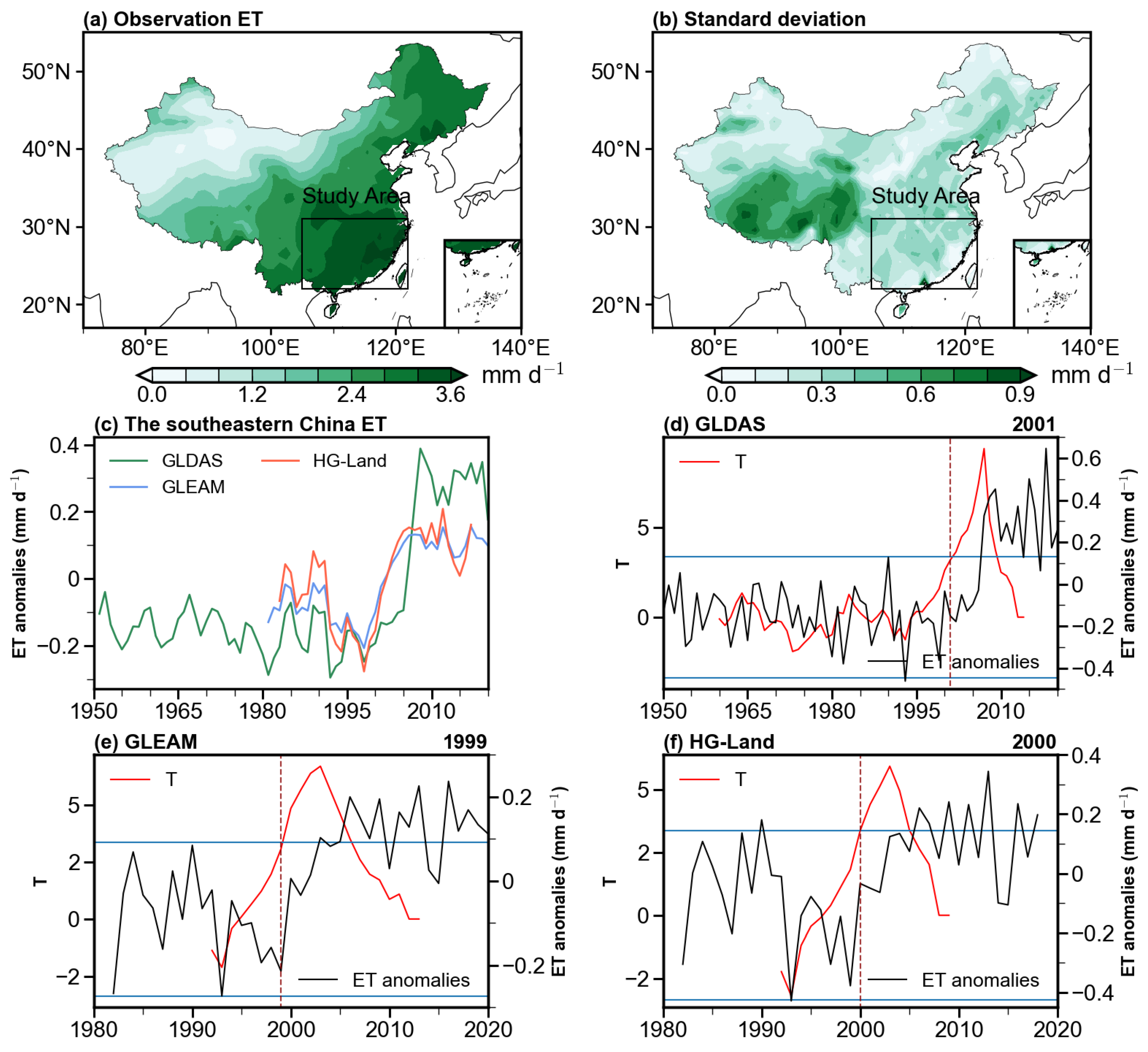




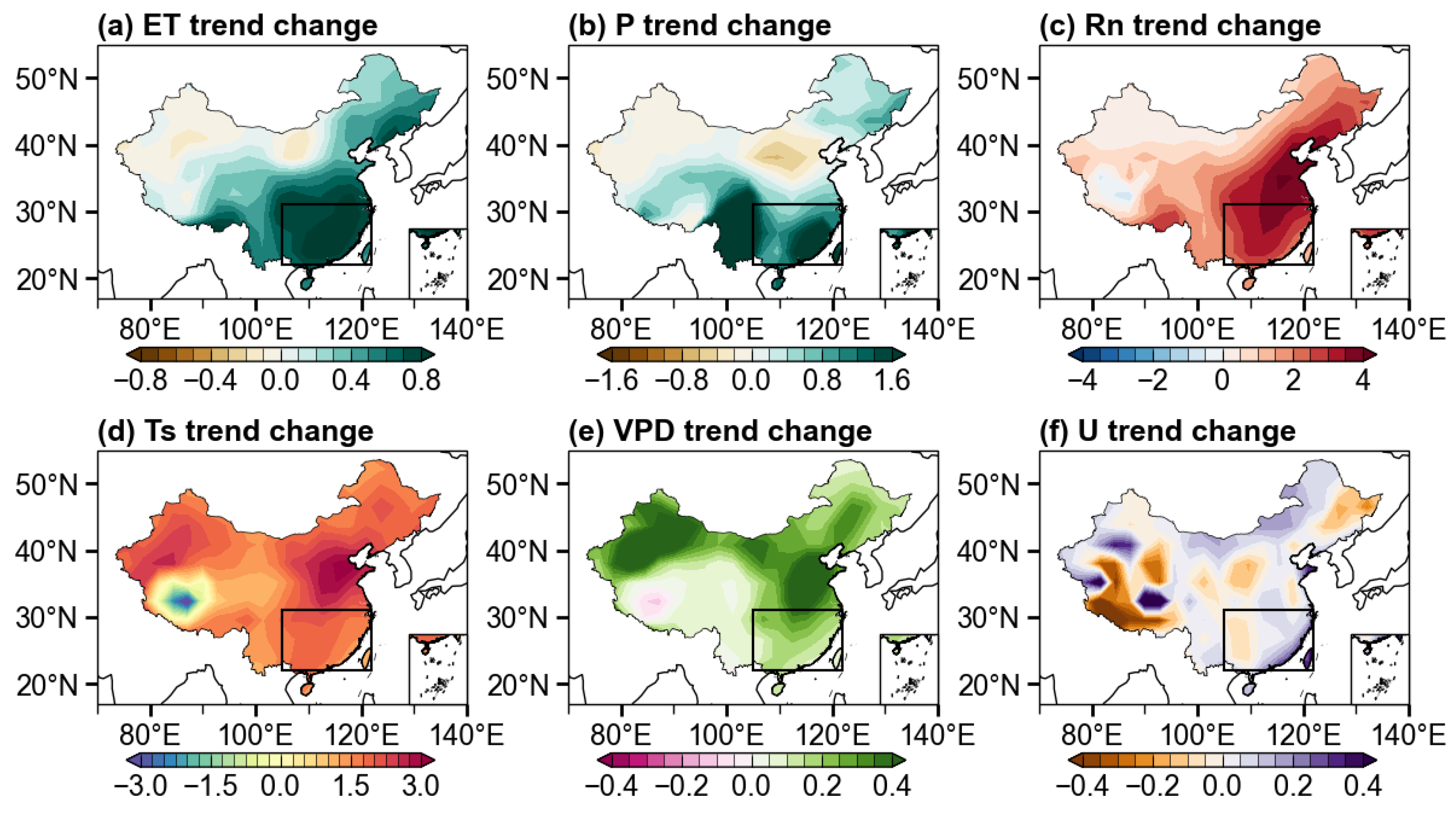
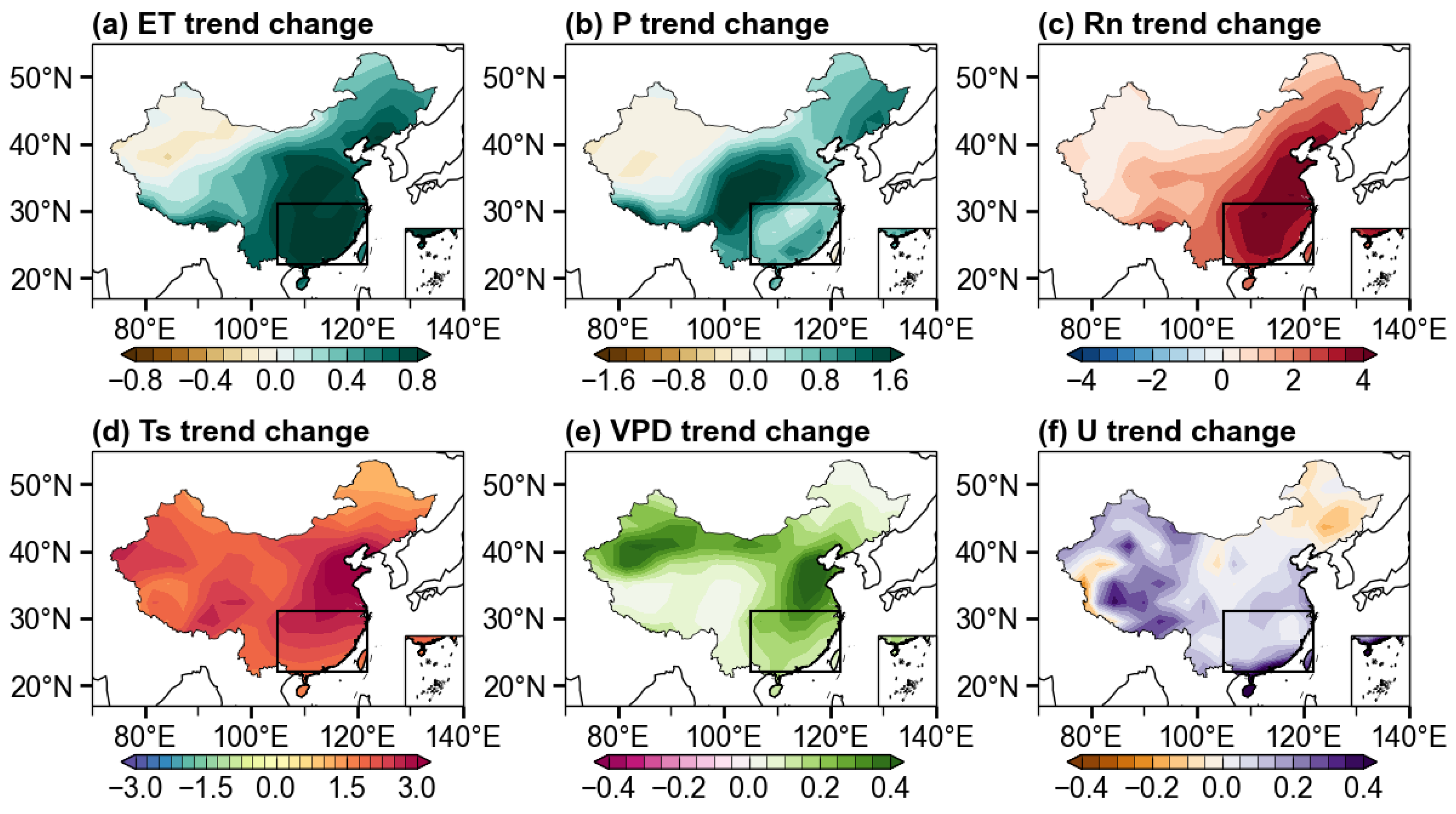
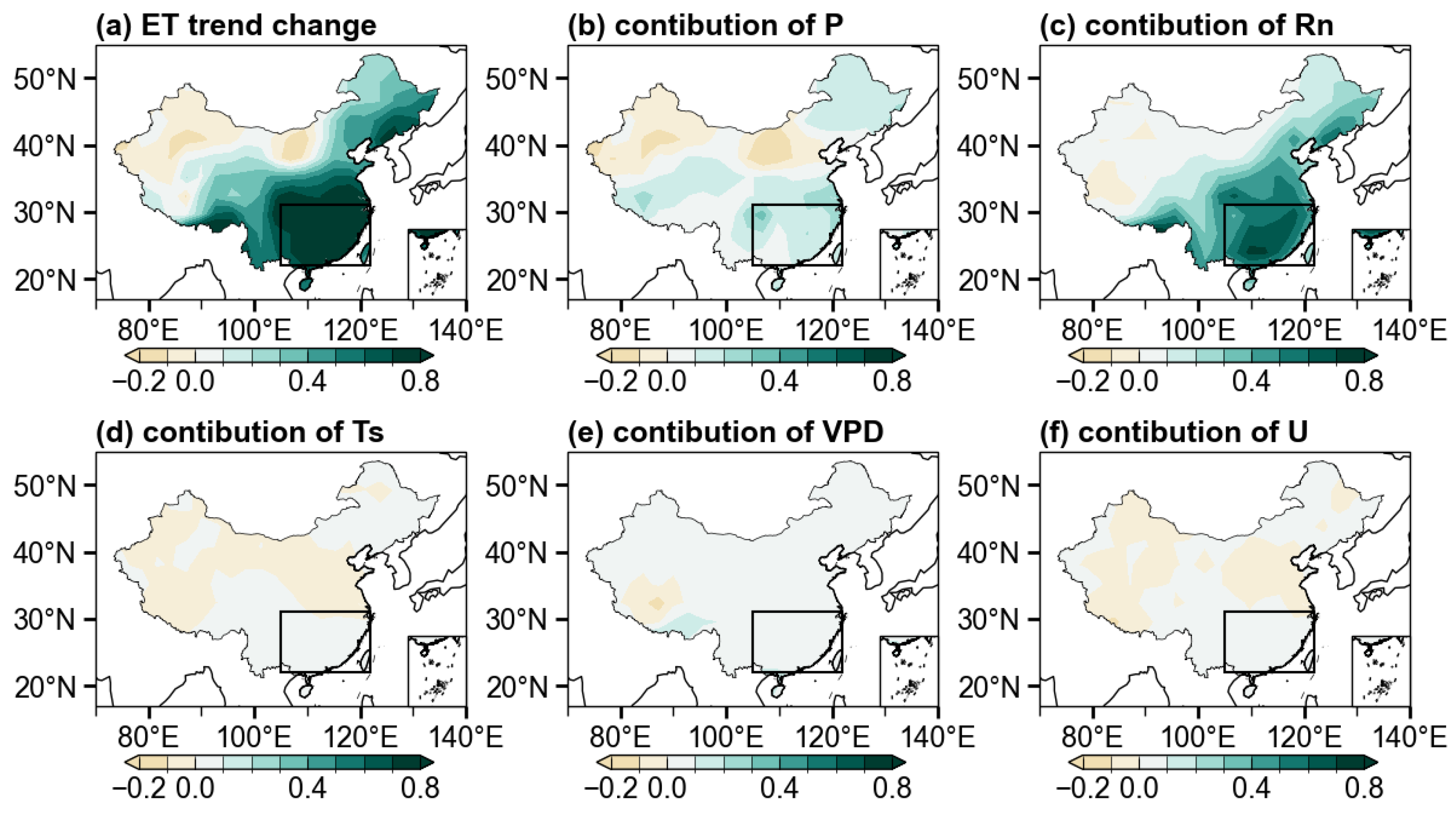
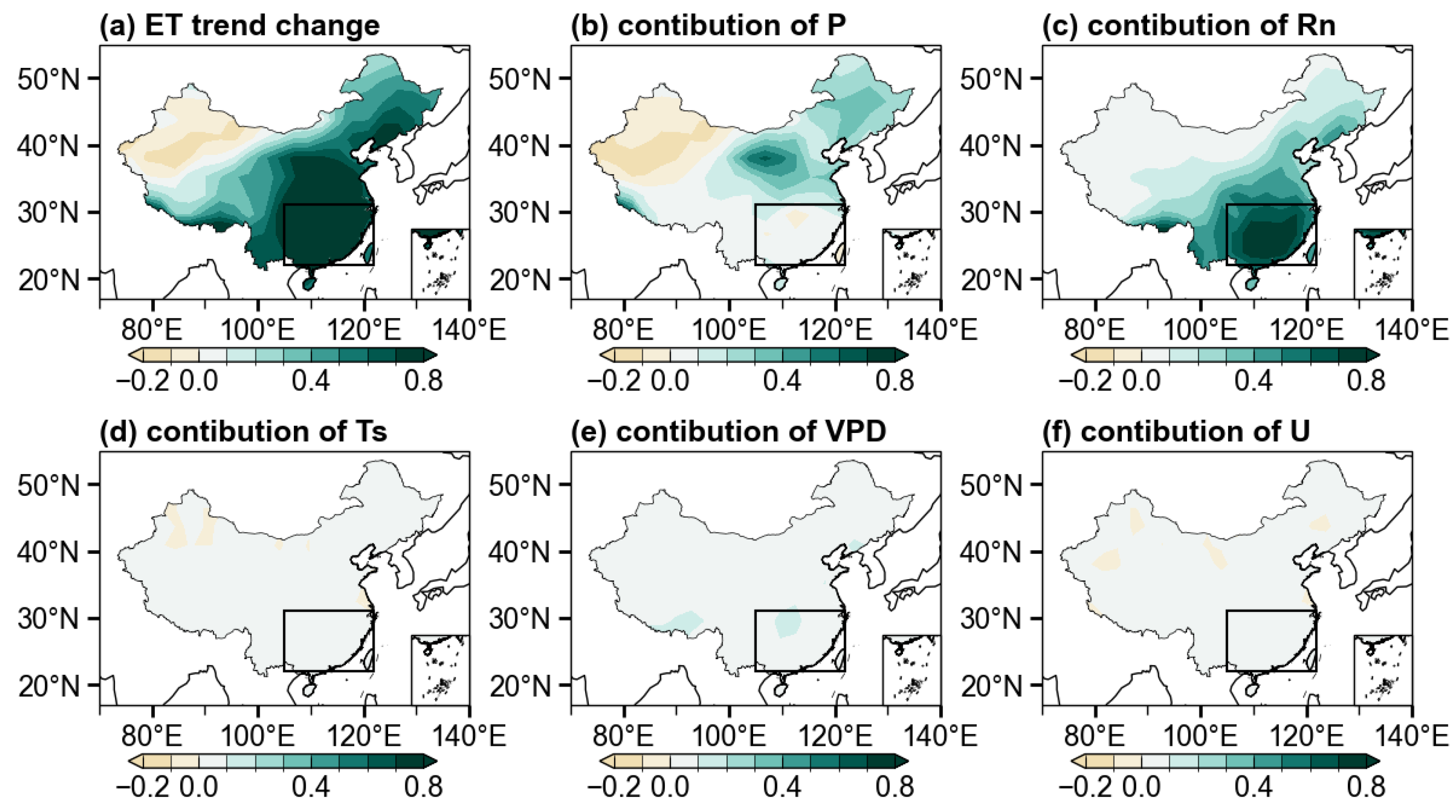
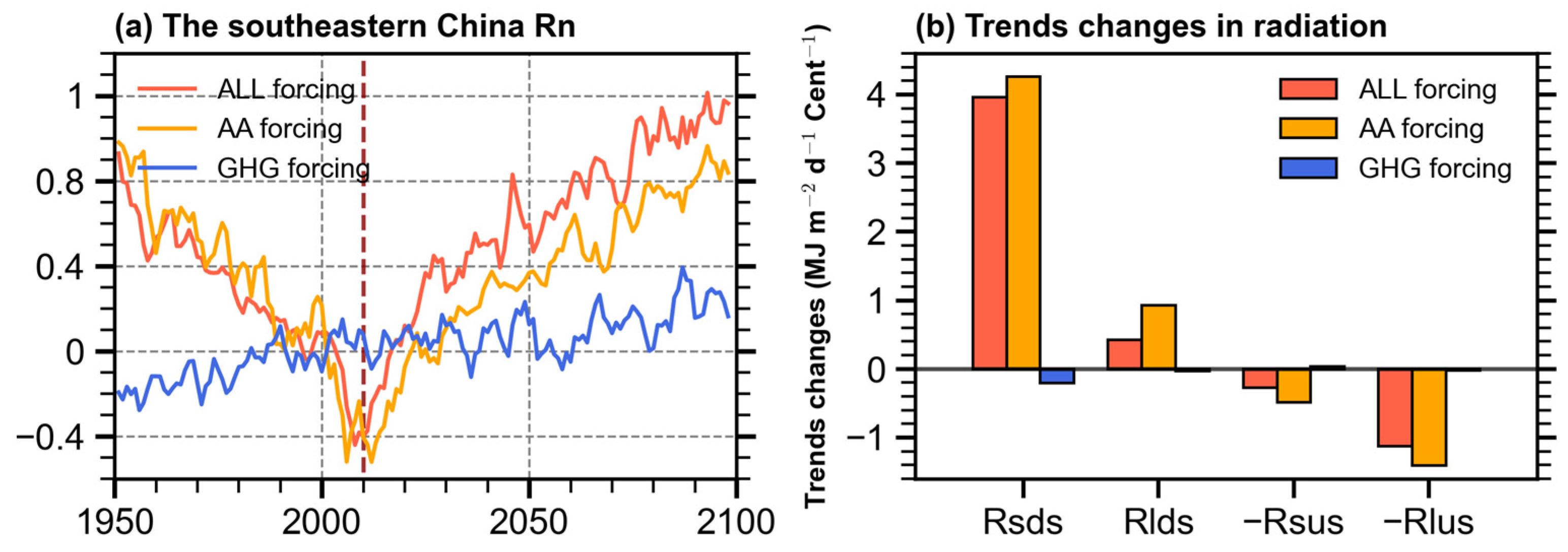

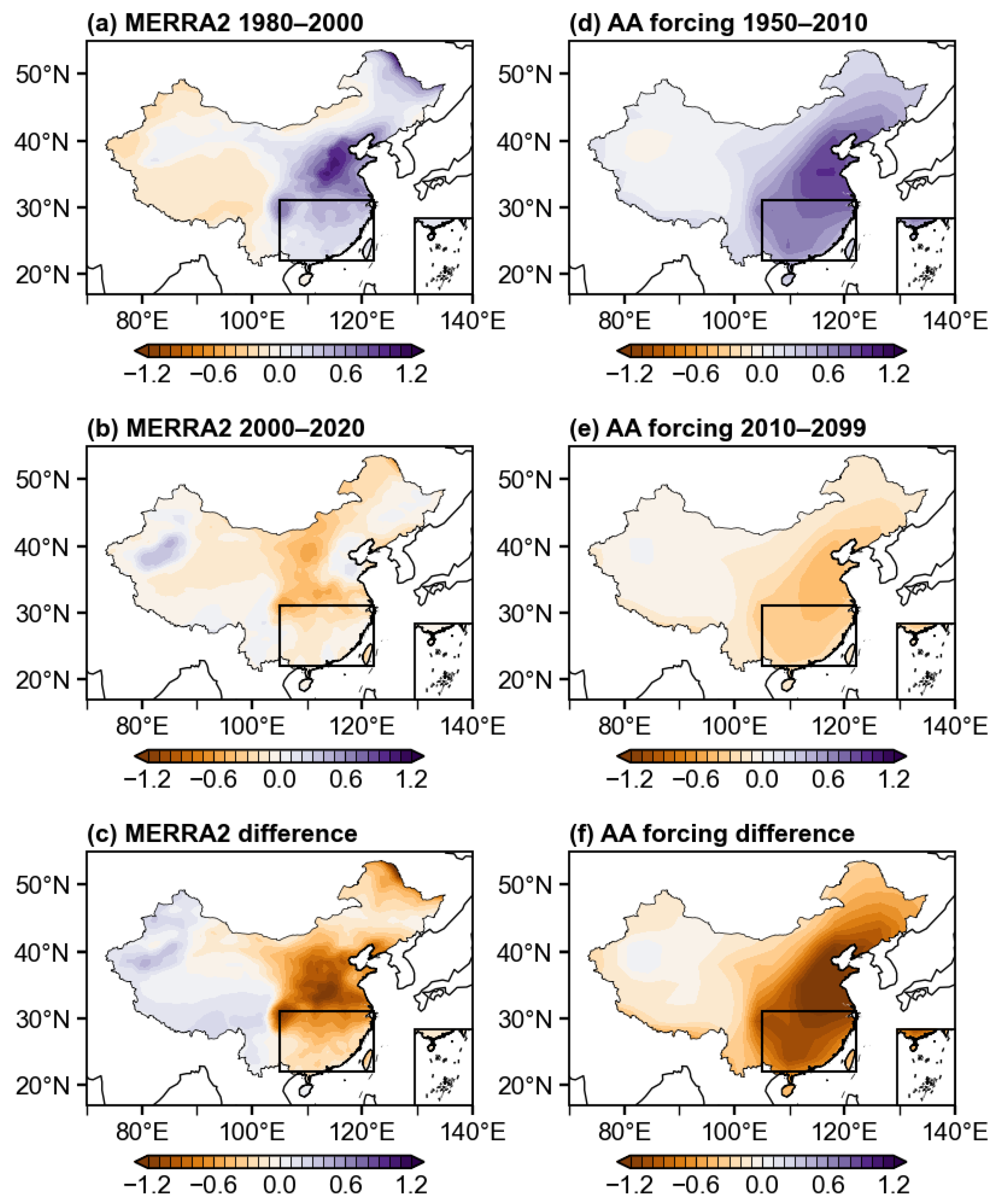
| Model Name | Realizations (Number) |
|---|---|
| CanESM5 | r1i1p1f1-r10i1p1f1 (10) |
| GISS-E2-1-G | r1i1p1f2-r5i1p1f2 (5) |
| MIROC6 | r1i1p1f1-r10i1p1f1 (10) |
| NorESM2-LM | r1i1p1f1 (1) |
Disclaimer/Publisher’s Note: The statements, opinions and data contained in all publications are solely those of the individual author(s) and contributor(s) and not of MDPI and/or the editor(s). MDPI and/or the editor(s) disclaim responsibility for any injury to people or property resulting from any ideas, methods, instructions or products referred to in the content. |
© 2025 by the authors. Licensee MDPI, Basel, Switzerland. This article is an open access article distributed under the terms and conditions of the Creative Commons Attribution (CC BY) license (https://creativecommons.org/licenses/by/4.0/).
Share and Cite
Kong, Z.; Cao, J.; Wang, B. Anthropogenic Aerosol Dominates the Decadal Change in Evapotranspiration over Southeastern China in the Past Four Decades. Remote Sens. 2025, 17, 561. https://doi.org/10.3390/rs17030561
Kong Z, Cao J, Wang B. Anthropogenic Aerosol Dominates the Decadal Change in Evapotranspiration over Southeastern China in the Past Four Decades. Remote Sensing. 2025; 17(3):561. https://doi.org/10.3390/rs17030561
Chicago/Turabian StyleKong, Zhiyong, Jian Cao, and Boyang Wang. 2025. "Anthropogenic Aerosol Dominates the Decadal Change in Evapotranspiration over Southeastern China in the Past Four Decades" Remote Sensing 17, no. 3: 561. https://doi.org/10.3390/rs17030561
APA StyleKong, Z., Cao, J., & Wang, B. (2025). Anthropogenic Aerosol Dominates the Decadal Change in Evapotranspiration over Southeastern China in the Past Four Decades. Remote Sensing, 17(3), 561. https://doi.org/10.3390/rs17030561





